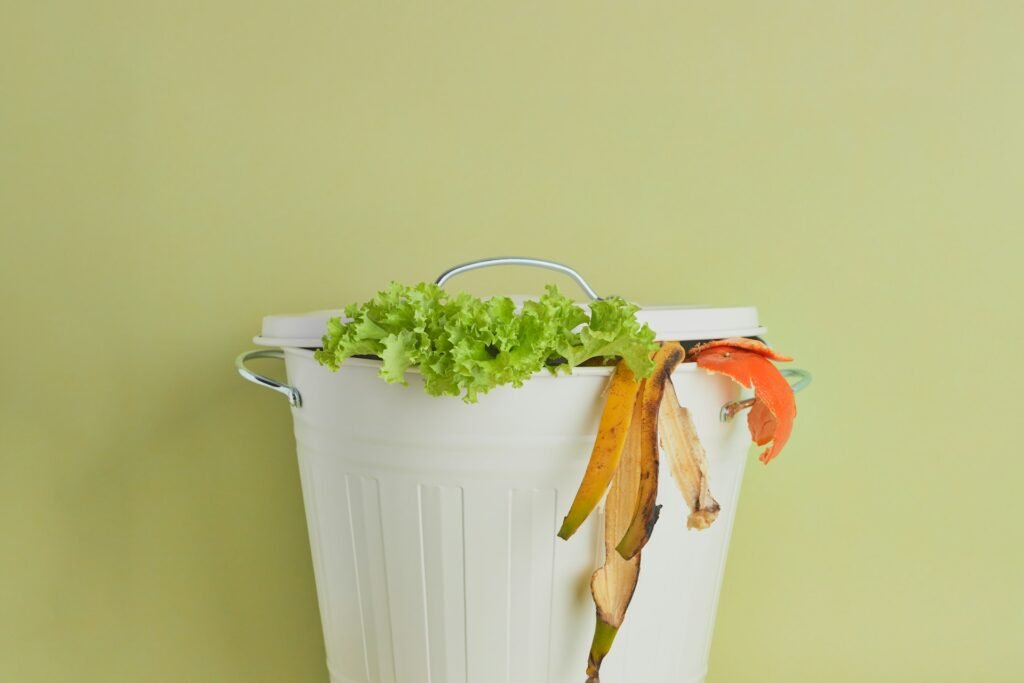Composting at home is a key step towards reducing one’s carbon footprint, and a kitchen compost bin is an essential tool for eco-friendly homes. These bins provide a convenient place to collect food scraps, coffee grounds, and egg shells, diverting them from landfills and returning nutrients to the soil. The right countertop compost bin will not only make composting simple but also blend seamlessly into your kitchen decor, encouraging regular use and contributing to a greener planet.
Ultimately, the best kitchen compost bin is one that you’ll use consistently, supporting your eco-friendly lifestyle. It should make the process of composting convenient, efficient, and even enjoyable, as you witness your kitchen waste transform into valuable compost for your garden. By choosing wisely, you’ll contribute to a healthier planet, one handful of food scraps at a time.
Comprehensive Review of Top Compost Bins
Our comprehensive review focuses on top contenders in the realm of composting, specifically those designed for kitchen use.
1. Epica Stainless Steel Compost Bin
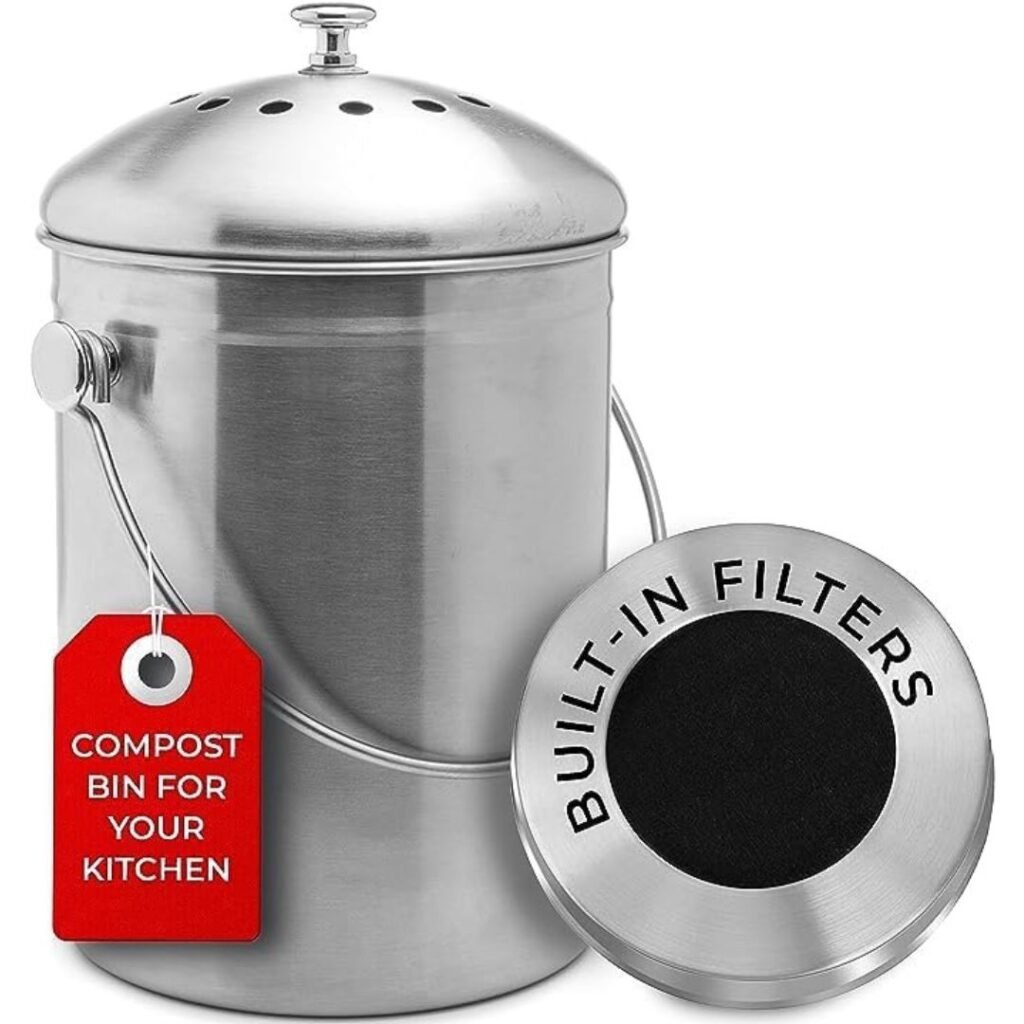
The Epica Stainless Steel Compost Bin is a popular choice for those looking to manage their food waste sustainably. This bin combines aesthetics with functionality, offering a sleek design that complements modern kitchen decor while providing a practical solution for organic waste collection. Its sturdy construction ensures longevity, making it a reliable addition to your composting arsenal.
Handling food waste with the Epica bin is a straightforward process, thanks to its convenient size and design. The bin’s compactness makes it an ideal fit for most kitchen countertops, allowing for easy access as you cook and prepare meals. With the Epica, contributing to a more sustainable future is made elegant and effortless.
The Epica Stainless Steel Compost Bin is crafted to address the common concerns of indoor composting. Its removable lid is a standout feature, providing ease of access for adding food waste and simplifying the cleaning process. This design choice ensures that maintaining your compost bin is as hassle-free as possible.
Constructed with high-quality stainless steel, the Epica bin is resistant to rust and leaks, making it a durable option that can withstand the acidic nature of composting materials. The bin’s compact size allows it to fit conveniently on your countertop without taking up excessive space, proving that practicality can coexist with style.
Pros
- Sleek, modern design that complements kitchen decor
- Durable stainless steel construction resistant to rust and leaks
- The compact size fits well on most countertops
- Includes a charcoal filter for odor control
- Removable lid for easy cleaning and access
Cons
- May be too small for larger households or those producing more food waste
- Requires periodic replacement of charcoal filters
- Stainless steel exterior might show fingerprints and require frequent wiping
2. Exaco ECO 2000 Kitchen Compost Pail, 2-gallon
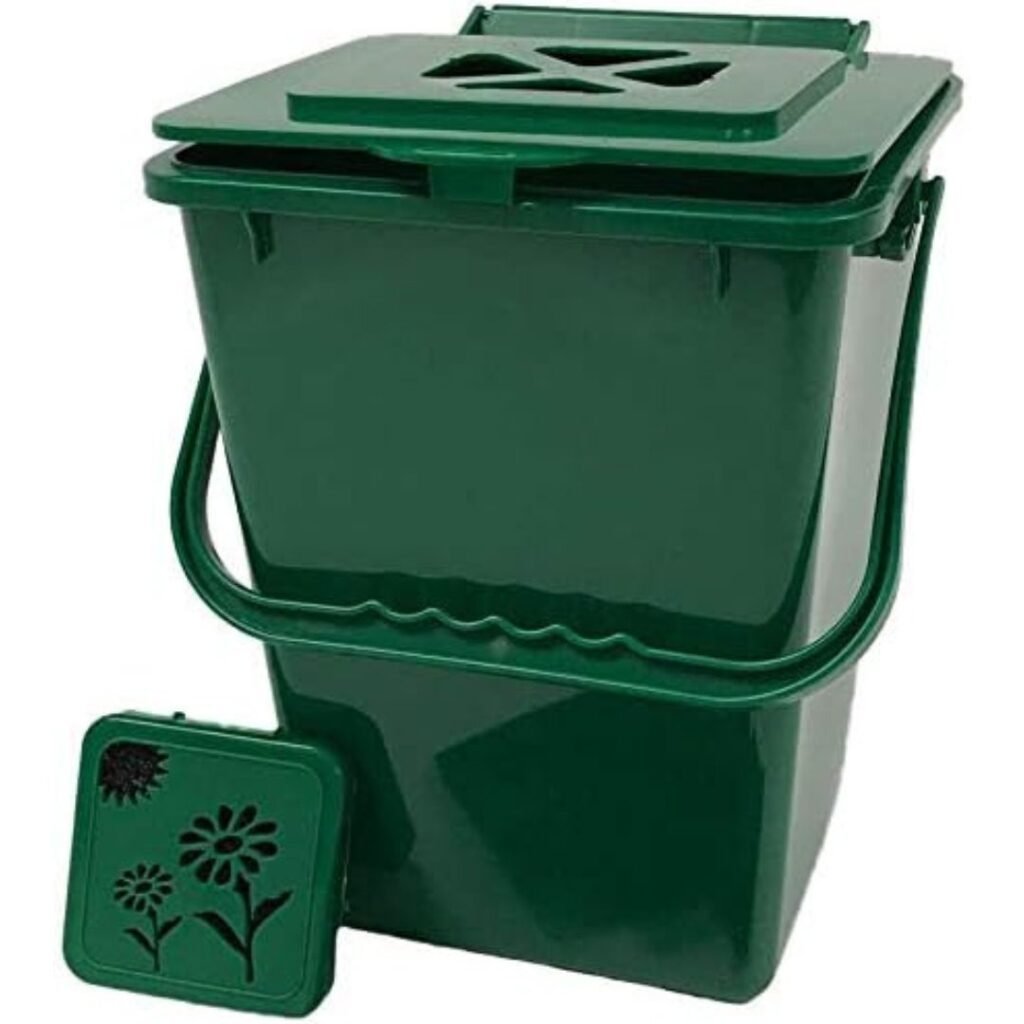
The Exaco ECO 2000 Kitchen Compost Pail is a larger option for households that produce more organic waste or for those who prefer less frequent emptying of the bin. With a 2-gallon capacity, this compost pail can accommodate a substantial amount of food scraps before needing to be emptied, making it a practical choice for busy kitchens.
Its robust design ensures that the compost pail can handle the demands of daily use, and its larger size does not compromise its suitability for kitchen use. The Exaco ECO 2000 is designed to be user-friendly, making the composting process straightforward and convenient for all household members.
The Exaco ECO 2000 Kitchen Compost Pail is designed with user convenience in mind. Its removable lid allows for easy disposal of food scraps and simplifies the task of cleaning the bin. The lid’s secure fit also aids in containing any potential odors, keeping your kitchen environment pleasant.
Constructed from high-quality materials, the compost pail is durable and made to last. Its size is balanced by a thoughtful design that ensures it remains manageable and easy to handle, even when full. The Exaco ECO 2000 is a solid choice for those who value capacity and convenience in their composting endeavors.
Pros
- Large 2-gallon capacity reduces emptying frequency
- Robust design suitable for daily use in busy kitchens
- Removable lid for easy disposal and cleaning
- Secure-fitting lid helps contain odors
- Ideal for larger families or those generating significant kitchen waste
Cons
- Larger sizes may not be suitable for smaller kitchens or limited counter space
- Can be heavy when full, potentially making it difficult to carry
- May require more frequent cleaning due to the larger capacity
3. Typhoon Otto Compost Caddy
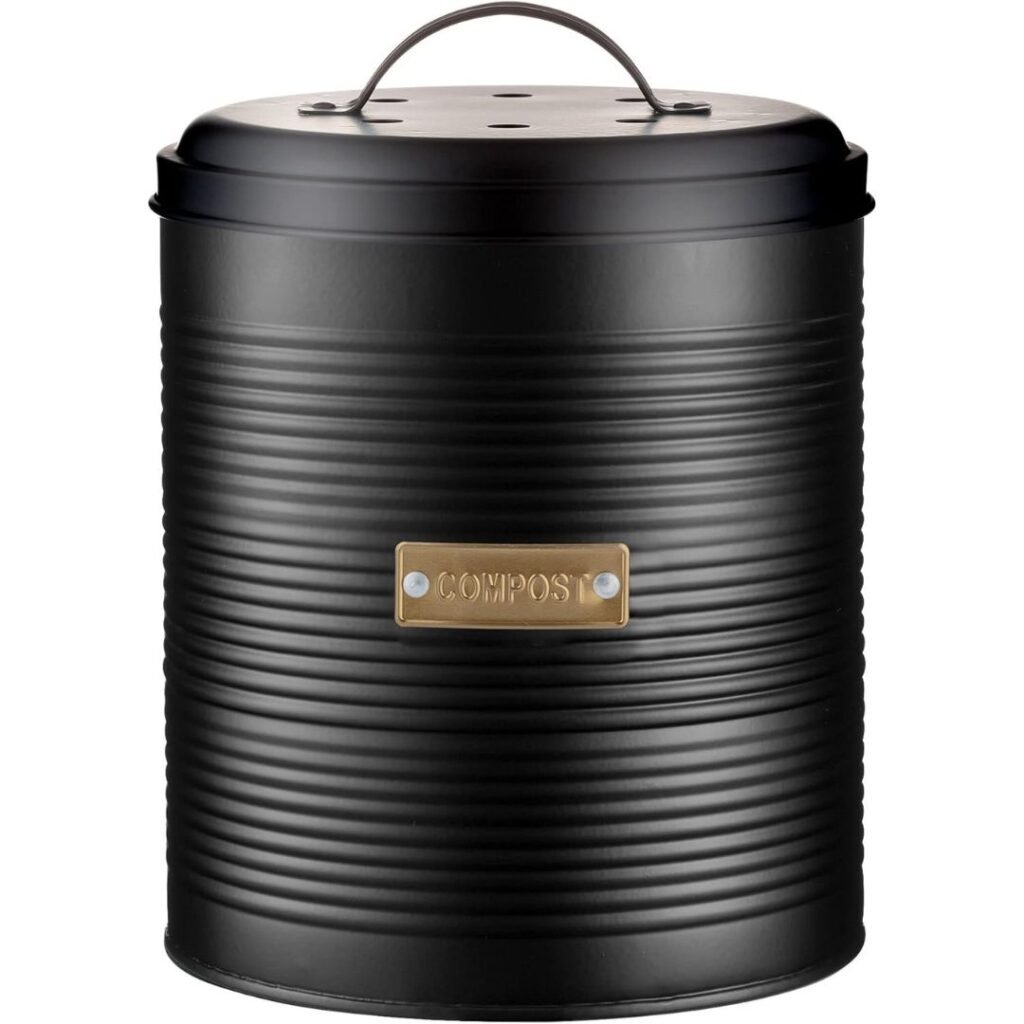
The Typhoon Otto Compost Caddy stands out with its vintage-inspired design and practical features. It is an attractive option for collecting food scraps on your kitchen counter, adding a touch of charm to the composting process. With its carbon filters, the caddy ensures that odors are well-contained, making it a pleasant companion in any kitchen.
Its hinged lid provides quick and easy access for adding scraps and cleaning, while the simple compost caddy design offers a modern alternative for those looking for a sleeker look. The Typhoon Otto is a versatile choice that meets various aesthetic preferences while remaining focused on environmental responsibility.
The Typhoon Otto Compost Caddy is equipped with a removable lid, which facilitates the daily addition of food scraps and simplifies the cleaning process. This feature, along with the inclusion of carbon filters, highlights the caddy’s commitment to odor control and user-friendliness.
Designed to be placed on the kitchen counter, the caddy’s size is perfect for day-to-day use without taking up too much space. Its durable construction ensures that it can withstand the acidity of compostable materials, making it a long-lasting option for eco-conscious households.
Pros
- Attractive vintage-inspired design that enhances kitchen decor
- Equipped with carbon filters for effective odor control
- Hinged lid for quick and easy access
- Durable construction withstands acidic compostable materials
- Suitable size for daily use without taking up too much space
Cons
- Vintage design may not suit all kitchen styles or modern decor
- Potentially smaller capacity compared to other options
- Carbon filters need a regular replacement for continued odor control
4. Simplehuman Compost Caddy Detachable and Countertop Bin
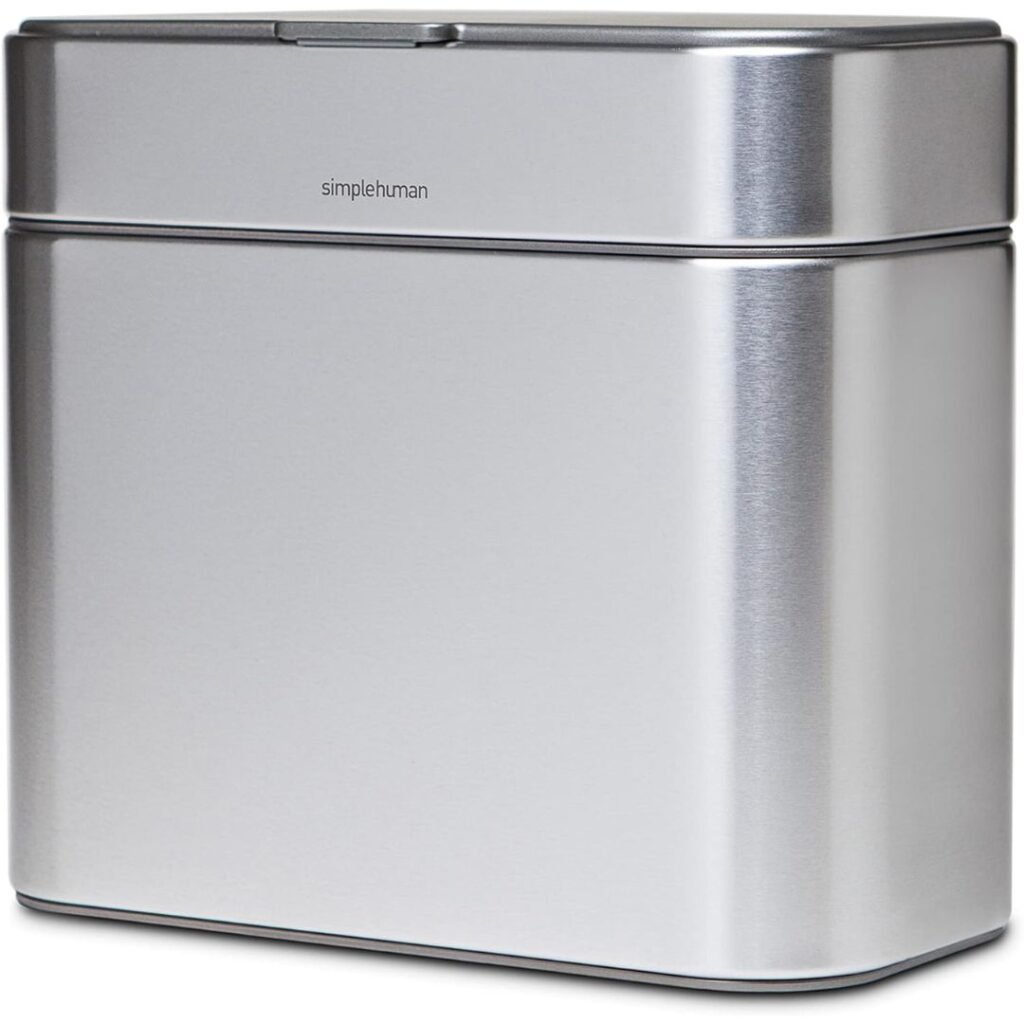
The simplehuman Compost Caddy Detachable and Countertop Bin is designed for those who prioritize convenience and sustainability. This bin makes it easy to separate food scraps, coffee grounds, and egg shells right on the countertop, ensuring that composting becomes an effortless part of your kitchen routine. Its detachable feature allows for quick transfer of compost to your outdoor pile or bin.
By choosing the simplehuman Compost Caddy, you’re making a conscious decision to reduce your carbon footprint with every use. The caddy’s sleek design ensures that it not only serves a functional purpose but also enhances the overall look of your kitchen. It’s a smart option for modern eco-friendly homes, marrying aesthetics with eco-conscious practices.
Pros
- The detachable design allows for easy transfer to outdoor compost
- A sleek, modern appearance enhances kitchen aesthetics
- Promotes consistent composting habits with user-friendly design
- Fits seamlessly into daily kitchen routines
- Contributes to reducing carbon footprint
Cons
- May have limited capacity compared to larger compost bins
- Potentially higher price point than simpler compost bin options
- The detachable feature may require more careful handling to avoid spills
5. OXO Good Grips 1 Gallon Easy-Clean Compost Bin
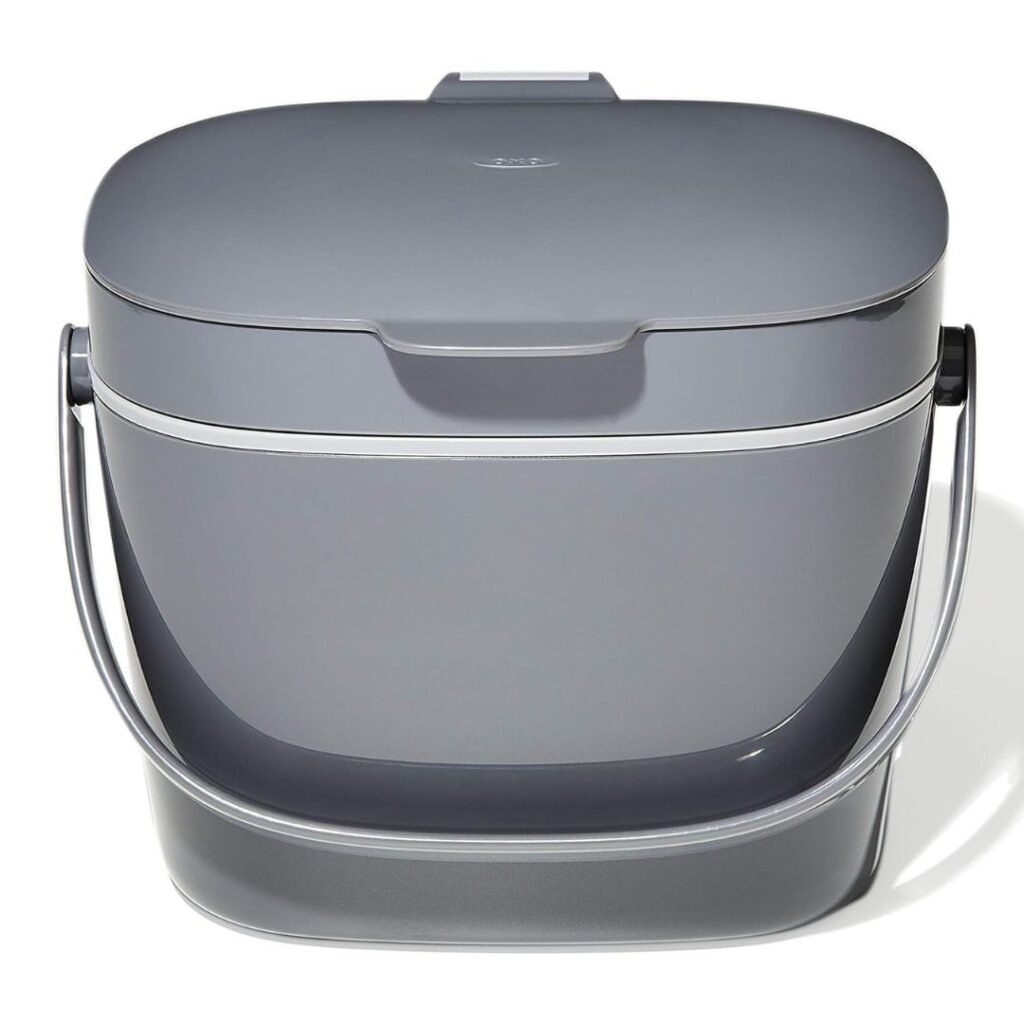
The OXO Good Grips Compost Bin is designed for efficiency and simplicity in managing kitchen food scraps. Its compact size ensures it fits comfortably on countertops without taking up too much space. The flip-up lid can be operated with one hand, making it easy to dispose of waste while cooking. Moreover, the lid locks in odors, ensuring a fresh kitchen environment.
Cleanliness is a breeze with this model, as the smooth interior walls prevent food from sticking and resist stains. The 1-gallon capacity is perfect for daily food scrap accumulation, and the bin can be easily emptied into larger outdoor compost bins or collection services. Additionally, it’s dishwasher safe, which simplifies cleaning.
The OXO Good Grips Compost Bin boasts a 1-gallon capacity, ideal for average-sized households. Its convenient size measures 7 inches in diameter and 7 inches in height, suitable for countertop use. The bin is constructed from durable plastic that is both BPA-free and easy to clean.
Feature-wise, it has a flip-up lid that can be opened and closed with one hand, and a rotating handle for easy transport. The lid’s design is also thoughtful, as it keeps odors contained within the bin. For maintenance, the interior is smooth, preventing waste from sticking, and the unit is dishwasher safe, ensuring hygiene and ease of cleaning.
Pros
- The compact design fits well on most kitchen countertops
- The flip-up lid can be operated with one hand for convenient use
- Smooth interior walls prevent food from sticking and facilitate easy cleaning
- Dishwasher safe for hassle-free maintenance
- Doesn’t require special bags or liners, promoting sustainability
Cons
- 1-gallon capacity may require frequent emptying for larger households
- Plastic construction, while durable, may not be as long-lasting as metal alternatives
- Limited color options may not suit all kitchen decor
6. Vitamix FoodCycler Eco 5 Food Composter
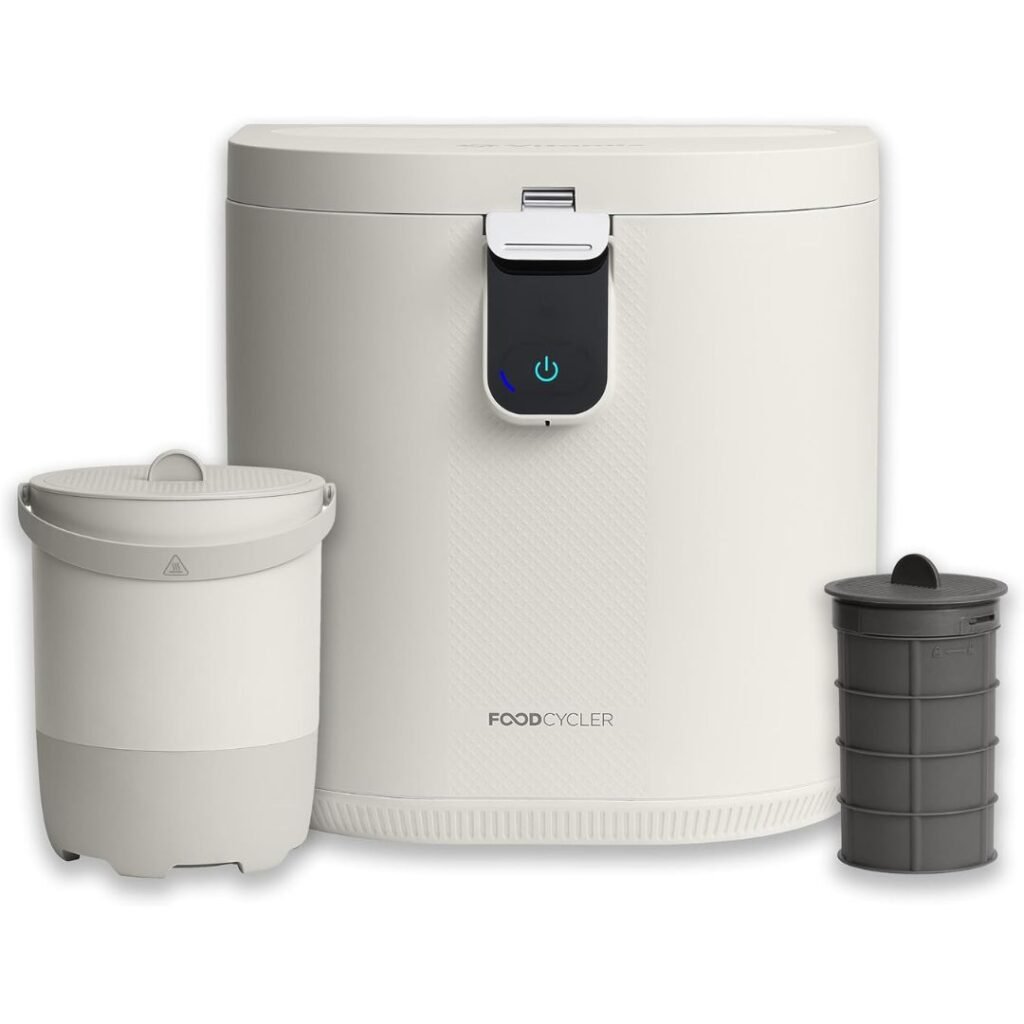
The Vitamix FoodCycler Eco 5 is at the forefront of kitchen compost technology, offering a convenient and odorless way to recycle food scraps into nutrient-rich compost. The device is compact, making it suitable for indoor use, even in apartments or homes with limited space. It transforms kitchen waste into compost in a matter of hours, providing a quick and efficient solution for food waste management.
With a carbon filtration system, the FoodCycler controls odors effectively, making it a pleasant addition to any kitchen. It’s designed to be user-friendly, with simple controls and an automatic shut-off feature for safety and energy conservation. This appliance represents a significant step towards sustainable living, reducing the amount of waste sent to landfills.
The Vitamix FoodCycler Eco 5 boasts a 2-liter capacity and a sleek, compact design that can fit on a countertop or be stored under the sink. It processes food scraps, including fruit cores, vegetable peels, and even small bones, into compost in just 3 to 8 hours, depending on the quantity and type of waste.
It features a carbon filter lid that neutralizes odors, ensuring that the composting process is discrete and unobtrusive. The device is also energy-efficient, using minimal electricity to convert food scraps into a dry, odorless, and nutrient-rich compost output, which can be added directly to the soil in gardens or potted plants.
Pros
- Transforms kitchen waste into compost in just 3 to 8 hours
- Compact design suitable for indoor use, even in small spaces
- Effective odor control with a carbon filtration system
- Processes a wide variety of food scraps, including small bones
- Energy-efficient operation
Cons
- Higher initial investment compared to traditional compost bins
- Requires electricity to operate, increasing energy consumption
- 2-liter capacity may necessitate frequent processing for larger households
- May require more maintenance than simpler compost bins
7. Lomi Composter
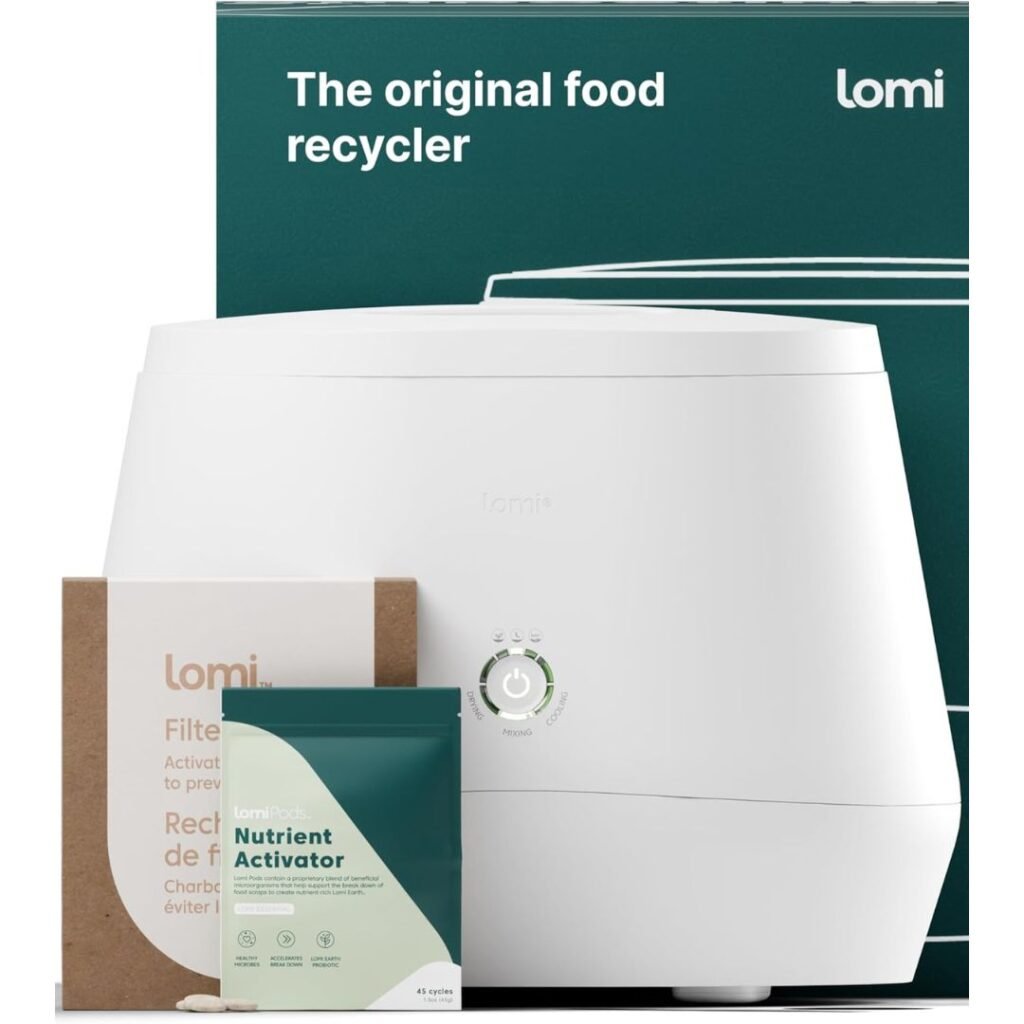
Lomi Composter is an innovative appliance that turns food scraps into compost right on the kitchen countertop. Its sleek design and quiet operation make it an unobtrusive addition to any eco-friendly home. Lomi is not only user-friendly but also accelerates the composting process, producing ready-to-use compost in just a few hours.
This electric composter is versatile, accepting a wide variety of food scraps, including fruits, vegetables, and even small bones. It’s an excellent solution for those looking to minimize their environmental impact and contribute to a greener planet by reducing the amount of organic waste sent to landfills.
Lomi Composter is designed to be compact and efficient, with dimensions that allow it to seamlessly integrate into any kitchen setup. It features a one-button start mechanism, making it exceptionally user-friendly. The machine also operates quietly, ensuring it does not disrupt the home environment.
It utilizes a combination of heat, abrasion, and oxygen to break down food scraps into a nutrient-rich compost. The unit comes with a carbon filter, which helps to eliminate any potential smells during the composting process. Additionally, the Lomi Composter is energy efficient, using only minimal electricity to operate.
Pros
- Produces ready-to-use compost quickly, in just a few hours
- Sleek, modern design that fits well in contemporary kitchens
- Quiet operation, minimizing disruption to the home environment
- User-friendly with a simple one-button start mechanism
- Accepts a wide variety of food scraps for composting
Cons
- Higher price point compared to traditional compost bins
- Requires electricity, which may increase energy consumption
- May have limited capacity compared to outdoor composting systems
- Regular maintenance is needed, including cleaning and filter replacement
Best Kitchen Compost Bins: A Comprehensive Guide
Size Matters: Choosing the Right Capacity
When selecting compost bins, capacity is a crucial factor to consider. The size should align with the amount of food waste a household produces and the available space in the kitchen. Small countertop bins are ideal for individuals or small families, while larger bins may be necessary for households that produce a significant amount of food scraps.
Choosing the right capacity ensures that the bin is emptied at an appropriate frequency, preventing overfilling and reducing the likelihood of odors. It also affects how frequently the contents need to be transferred to an outdoor compost pile or local collection service. Therefore, assessing daily food waste output is essential before making a purchase.
For those with limited space, a compact compost bin that can be conveniently placed on the countertop or tucked away under the sink is ideal. Conversely, homes with more space and greater composting needs might opt for larger bins that can hold several gallons of food scraps before requiring disposal.
Material Considerations: Durability and Aesthetics
The materials of compost bins greatly influence their durability and aesthetic appeal. Stainless steel exteriors offer a sleek, modern look and are resistant to rust and corrosion, making them a durable choice for many kitchens. On the other hand, the simple human compost caddy showcases a steel exterior that combines durability with style, fitting seamlessly into modern kitchen designs.
Plastic liners within compost bins are common due to their lightweight nature and ease of cleaning. Countertop bins often incorporate plastic liners that can be removed and washed separately, simplifying maintenance. When selecting a compost bin, it’s important to consider the longevity of the materials and choose one that not only looks good but will also withstand the test of time.
In addition to functionality, the aesthetic appeal of compost bins should not be overlooked, as they often remain in plain view. Many individuals prefer compost bins that blend with their kitchen decor, maintaining a cohesive look. A balance between durability and aesthetics ensures that the compost bin is both a practical and visually pleasing addition to the kitchen.
Odor Control: Filters and Lids that Make a Difference
One crucial aspect of selecting a compost pail is ensuring it has adequate odor control measures. A hinged lid is a must-have feature, providing easy access while keeping unpleasant smells contained. To further combat odors, many kitchen compost bins, like the OXO Easy-Clean Compost Bin, come equipped with charcoal filters. These filters are instrumental in absorbing and neutralizing foul smells, making the composting experience more pleasant for everyone in the household.
Charcoal filters, however, do require regular replacement to maintain their effectiveness. Users should consider the availability and cost of these filters when choosing their compost pail. Moreover, a perfectly fitted lid plays an important role in odor control. For instance, the Brabantia Sort & Go Waste Bins feature a tight seal, which prevents the escape of any odorous air, ensuring that the kitchen counter remains a fresh and inviting space.
Lastly, a compost keeper that combines both a secure lid and a reliable odor filter can provide the best of both worlds. This integrated approach to odor management allows the compost bin to function efficiently without compromising the air quality of the kitchen environment. With these features in place, eco-friendly homes can maintain a clean and odor-free kitchen while contributing to a greener planet.
Ease of Use: Features that Enhance User Friendliness
For composting to become a seamless part of kitchen activities, ease of use is paramount. Compost bins designed for the kitchen counter should offer convenience at every turn. Features such as a wide opening for simple scrap disposal, lightweight construction for ease of handling, and a dishwasher-safe design for quick cleaning are important considerations. The OXO Easy-Clean Compost Bin, for example, is known for its user-friendly design that simplifies the composting process for the everyday user.
Furthermore, a kitchen compost bin with a removable liner can make transferring waste to an outdoor compost pile or green waste bin much easier, minimizing mess and hassle. The ideal bin will also have a handle or grips to enable users to carry it outside with ease. Ergonomically designed compost bins not only encourage more frequent use but also make the eco-friendly practice of composting more accessible to people of all ages.
Lastly, the placement of the compost bin can affect its use. A compact design that fits neatly on the kitchen counter or under the sink allows for easy access while preparing food, choosing to compost as straightforward as throwing waste in the trash. By prioritizing user-friendly features, families can integrate sustainable practices into their daily routines without any added inconvenience.
Aesthetic Appeal: Compost Bins That Blend With Your Kitchen Decor
While functionality is key, the visual appeal of a compost bin can’t be overlooked. Many homeowners desire a compost pail that complements their kitchen decor rather than detracting from it. A stainless steel compost bin, for example, offers a sleek and modern look that can enhance the kitchen’s ambiance while serving its practical purpose. Its reflective surface and neutral color make it a versatile choice that can blend with various interior designs.
In addition to materials, the design of the compost bin plays a significant role in its aesthetic appeal. Compost bins with a minimalist design or in colors that match the kitchen cabinetry and appliances can become a subtle yet stylish part of the kitchen ensemble. Even the presence of an odor filter, often hidden from view, contributes to maintaining a clean and pleasant appearance by preventing any sign of waste or smell.
Lastly, the food composter should not only look good but also feel good to use. Smooth lines, a comfortable handle, and a form that’s pleasant to touch can make the daily task of composting a more enjoyable experience. As a result, an attractive compost bin that matches the kitchen’s aesthetic can encourage more consistent use and support sustainable living habits.
Comparing Prices and Value for Money
When evaluating kitchen compost bins, the price is a significant factor, but it should be balanced against the value for money. Cheaper models might save on initial costs but could lack durability or effective odor control, leading to additional expenses in replacements or filters. Conversely, pricier options often come with enhanced features such as better construction materials, more sophisticated odor filters, and user-friendly designs.
It’s worthwhile to consider how the compost bin will fit into one’s lifestyle and how often it will be used. A higher upfront investment in a quality compost bin can pay off in the long run through ease of use and longevity. Additionally, some models come with warranties or customer support, adding value beyond the purchase price.
Ultimately, comparing compost bins should involve assessing the balance between cost, features, and the user’s specific needs. By doing so, consumers can select a compost bin that provides the best value for money, aligning with their commitment to sustainability without compromising on quality or functionality.
Kitchen Compost Bins Guide: Frequently Asked Questions
1. Can all food scraps be composted?
No, not all food scraps are suitable for home composting. While items like vegetable peels, fruit scraps, and coffee grounds are perfect for composting, meats, dairy products, and oily foods should be avoided. These latter items can create odors and attract pests, making them less ideal for typical home composting setups. It’s crucial to understand the balance of ‘green’ (nitrogen-rich) and ‘brown’ (carbon-rich) materials for a healthy compost. Educating yourself on appropriate composting items ensures a successful, odor-free process and contributes to nutrient-rich compost for gardens and plant beds.
2. What are the best practices for managing a full compost bin?
When your compost bin reaches capacity, proper management is key. The best practice is to transfer the contents to a larger outdoor composting system or a community garden’s compost pile. If these aren’t options, consider using municipal composting services. It’s important to regularly monitor the volume of waste in your bin and maintain a consistent disposal routine to prevent overfilling and potential odor issues. By being proactive, you can ensure your compost bin remains an effective tool in your waste reduction efforts.
3. How often should I empty my compost bin?
The optimal frequency for emptying your compost bin depends on the amount of food waste you generate and the size of your bin. For smaller households or those producing less waste, once a week may be sufficient. Larger families or frequent cooks might need to empty their bins more often, possibly every few days. Pay attention to your bin’s capacity and any signs of odor to determine the right schedule for your needs. Maintaining a regular emptying routine helps keep your composting process clean and functional, reducing the likelihood of unpleasant smells or pests.
4. Are compost bin liners biodegradable?
Compost bin liners can be biodegradable, but it’s important to choose the right ones. Ideally, liners should be fully biodegradable to break down effectively within the compost pile. Plant-based or paper liners are good options as they can contribute to the overall health of the compost, decomposing alongside the organic waste. When selecting liners, verify their biodegradability certifications and avoid any containing plastics or other non-compostable materials. By choosing the right liners, you can ensure your composting process remains eco-friendly from start to finish.
5. What’s the difference between a compost bin and a composter?
While often used interchangeably, ‘compost bin’ and ‘composter’ refer to different stages in the composting process. A compost bin is typically a smaller container used in the kitchen to collect daily food scraps. Its main function is the temporary storage of organic waste before transfer to a larger system. In contrast, a composter is usually a larger outdoor unit where the actual breakdown of organic material into compost occurs. Understanding this distinction helps in selecting appropriate equipment for each phase of the composting process and ensures more efficient recycling of kitchen waste.
The Final Verdict on the Best Kitchen Compost Bin
After carefully considering a range of factors, the Epica Stainless Steel Compost Bin stands out as a top performer. The Epica bin’s stainless steel design resists rust and leaks, while the included activated charcoal filter ensures that contained odors stay inside the bin, making it a favorite compost container for indoor use. Unlike plastic bins, the durable construction of the Epica bin also contributes to its longevity, making it a valuable addition to any eco-friendly kitchen.
The OXO Good Grips Easy-Clean Compost Bin is another excellent choice, especially for those needing a compact solution. The OXO bin, with its convenient flip-up lid and smooth plastic insert, makes it easy to empty your compost without a mess. Its design integrates well with other food storage containers, and the size is perfect for everyday kitchen waste like tea leaves and vegetable peelings. Although not as robust as a compost tumbler for aerobic decomposition, it is an ideal indoor composter for daily use.
In conclusion, while the best kitchen compost bin for your home will depend on your specific needs, the Epica Stainless Steel Compost Bin and OXO Good Grips Compost Bin are both top contenders. They offer easy ways to manage waste, prevent attracting fruit flies, and can be used with a compostable bag or bag liner made of recycled plastic for convenient disposal. When paired with outdoor options, they form an effective system for turning kitchen waste into garden gold. Always remember to consider factors like capacity, ease of use, and how well a compost container will fit into your home’s aesthetic and green living practices.

